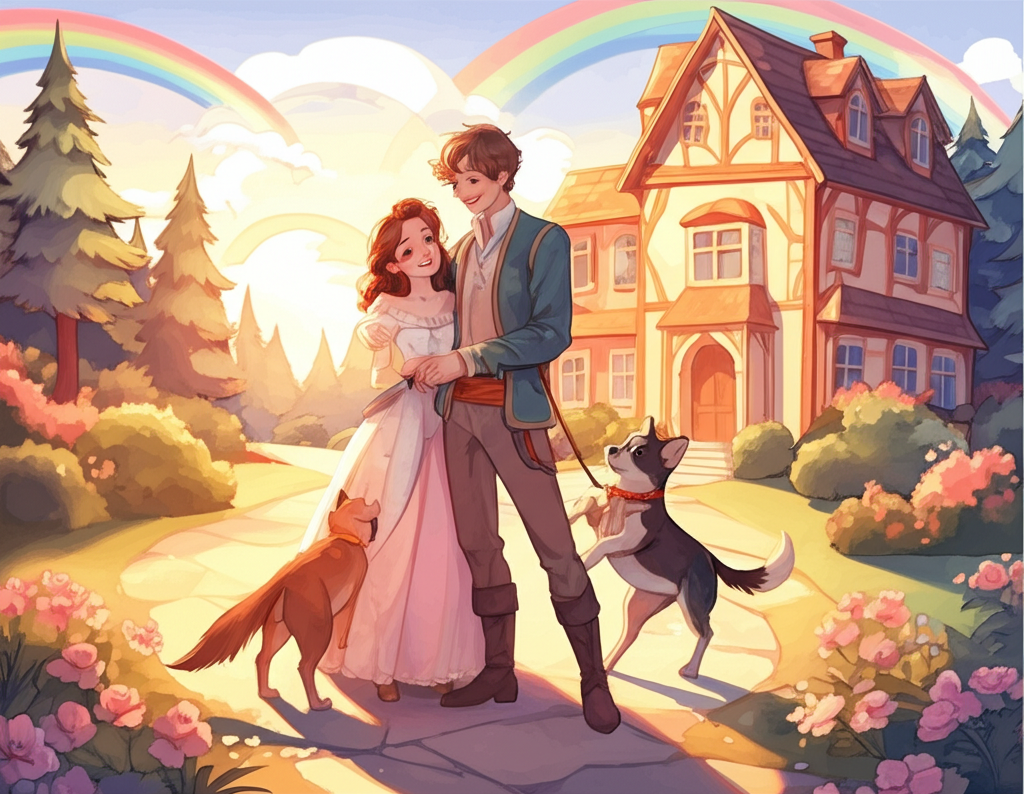
A dad gave his son 300 rupees and told him to go to another place and try to make money. The son took the money and left. He hadn’t gone very far when he saw some people arguing about a dog. Some of them wanted to hurt the dog. “Please don’t hurt the dog!” the kind son said. “I’ll give you 100 rupees for it.” So, they made a deal, and the son took the dog and kept going.
Next, he saw some people fighting over a cat. Some of them wanted to hurt it, but others didn’t. “Oh, please don’t hurt it!” he said. “I’ll give you 100 rupees for it.” Of course, they gave him the cat and took the money.
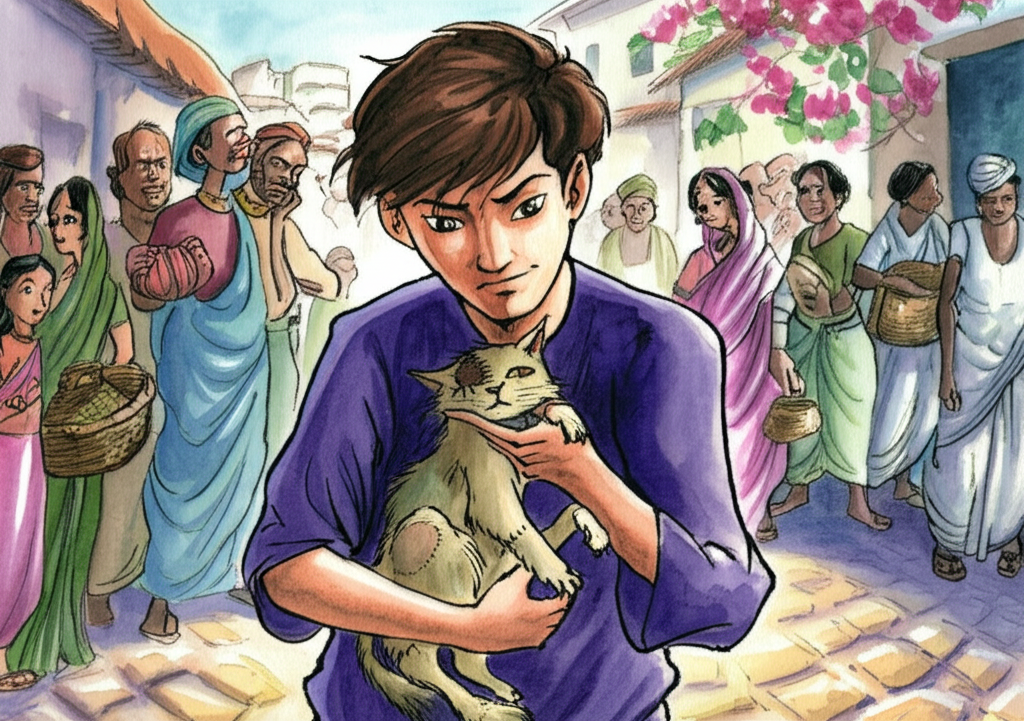
He kept walking until he got to a village where some people were arguing about a snake they had caught. Some wanted to hurt it, but others didn’t. “Please don’t hurt the snake!” he said. “I’ll give you 100 rupees.” Of course, the people agreed and were very happy to get the money.
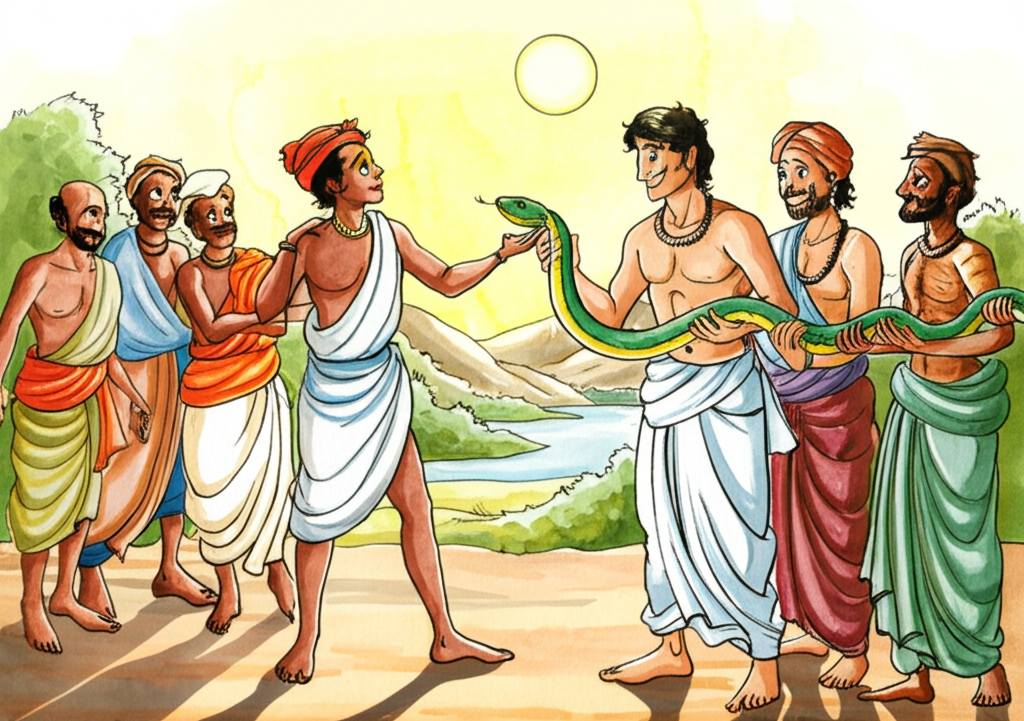
What a silly guy! What would he do now that all his money was gone? He had to go back to his dad. So, he went home.
“You silly goose!” his dad shouted when he heard how his son had wasted all the money. “Go live in the barn and feel sorry for being so foolish. You can’t come back in the house!”
So, the young man went to live in the barn. He slept on the grass meant for the animals, and his friends were the dog, the cat, and the snake he had bought. They all liked him a lot and followed him around all day. At night, the cat slept at his feet, the dog at his head, and the snake curled around him with its head on one side and its tail on the other.
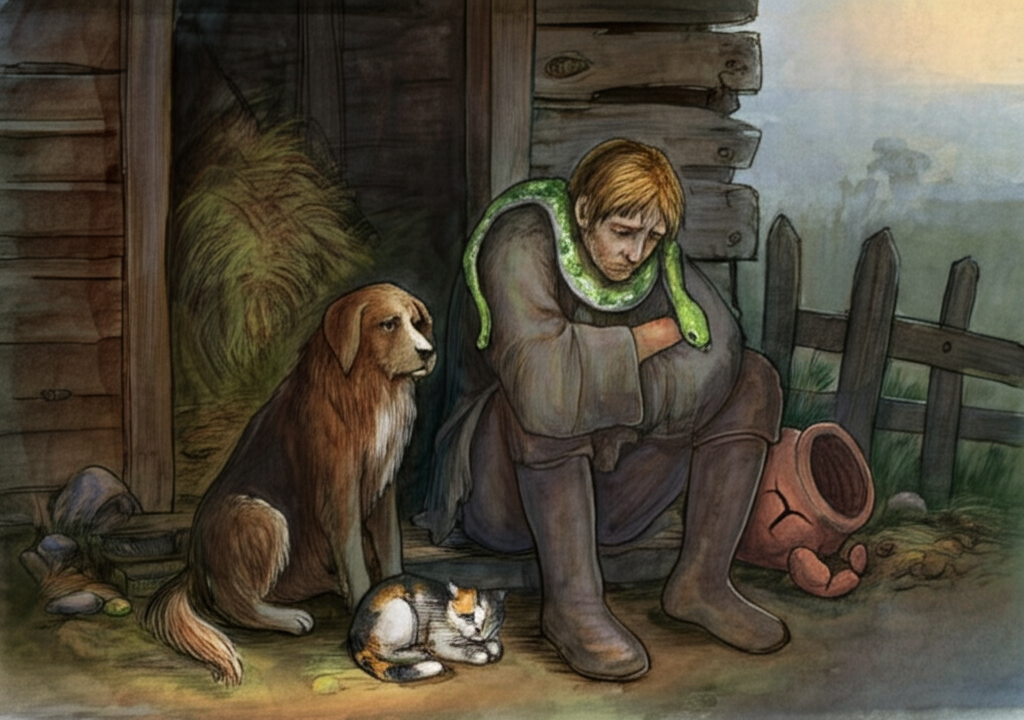
One day, the snake said to his master, “I’m the son of King Indrasha. One day, I came out to get some fresh air, and some people caught me. They would have hurt me if you hadn’t come to save me. I don’t know how I can ever thank you for being so kind. I wish you could meet my dad! He would be so happy to see who saved his son!”
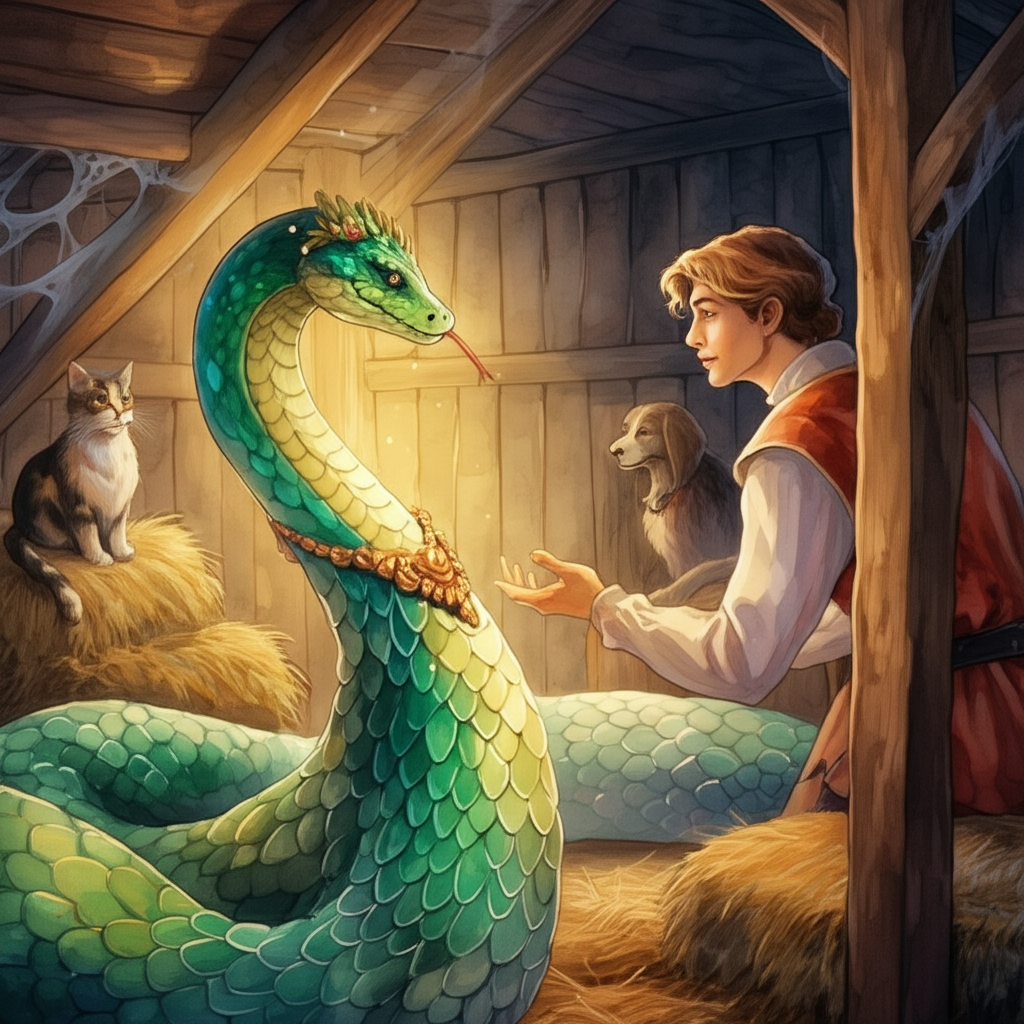
“Where does he live? I’d like to see him,” said the young man.
“Great!” said the snake. “Do you see that mountain over there? At the bottom of the mountain is a special spring. If you come with me and jump into that spring, we’ll both get to my dad’s land. Oh, he’ll be so happy to see you! He’ll want to give you a gift too. If he asks what you want, you should say, ‘The ring on your right hand, and the special pot and spoon you have.’ If you have those, you’ll never need anything. The ring is magic! You just talk to it, and a beautiful house will appear. And the pot and spoon will give you all kinds of yummy foods!”
With his three friends, the man walked to the spring and got ready to jump in, like the snake said. “Oh, master!” cried the cat and dog when they saw what he was going to do. “What will we do? Where will we go?”
“Wait for me here,” he said. “I’m not going far. I’ll be back soon.” Then, he jumped into the water and disappeared.
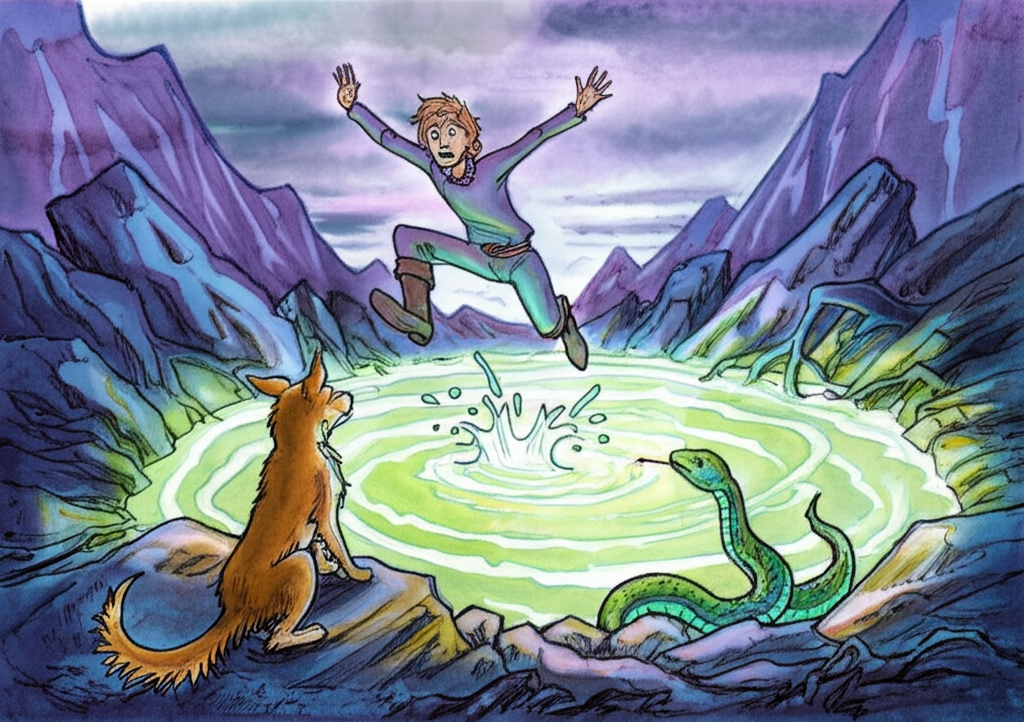
“Now what do we do?” the dog asked the cat.
“We have to stay here,” said the cat, “like our master told us. Don’t worry about food. I’ll go to the people’s houses and get food for us both.” And that’s what the cat did. They both lived comfortably until their master came back.
The young man and the snake arrived safely. The king was told that they were there. He told his son and the stranger to come see him. But the snake said he couldn’t go to his dad until he was free from the stranger, who had saved him from something terrible, so he was like his helper. Then, the king went and hugged his son. He said hello to the stranger and welcomed him to his land. The young man stayed there for a few days. The king gave him the ring, pot, and spoon to thank him for saving his son. Then he went back. When he got to the top of the spring, his friends, the dog and the cat, were waiting for him. They told each other everything that had happened since they last saw each other, and they were all very happy. Then, they walked to the river to try out the magic ring, pot, and spoon.
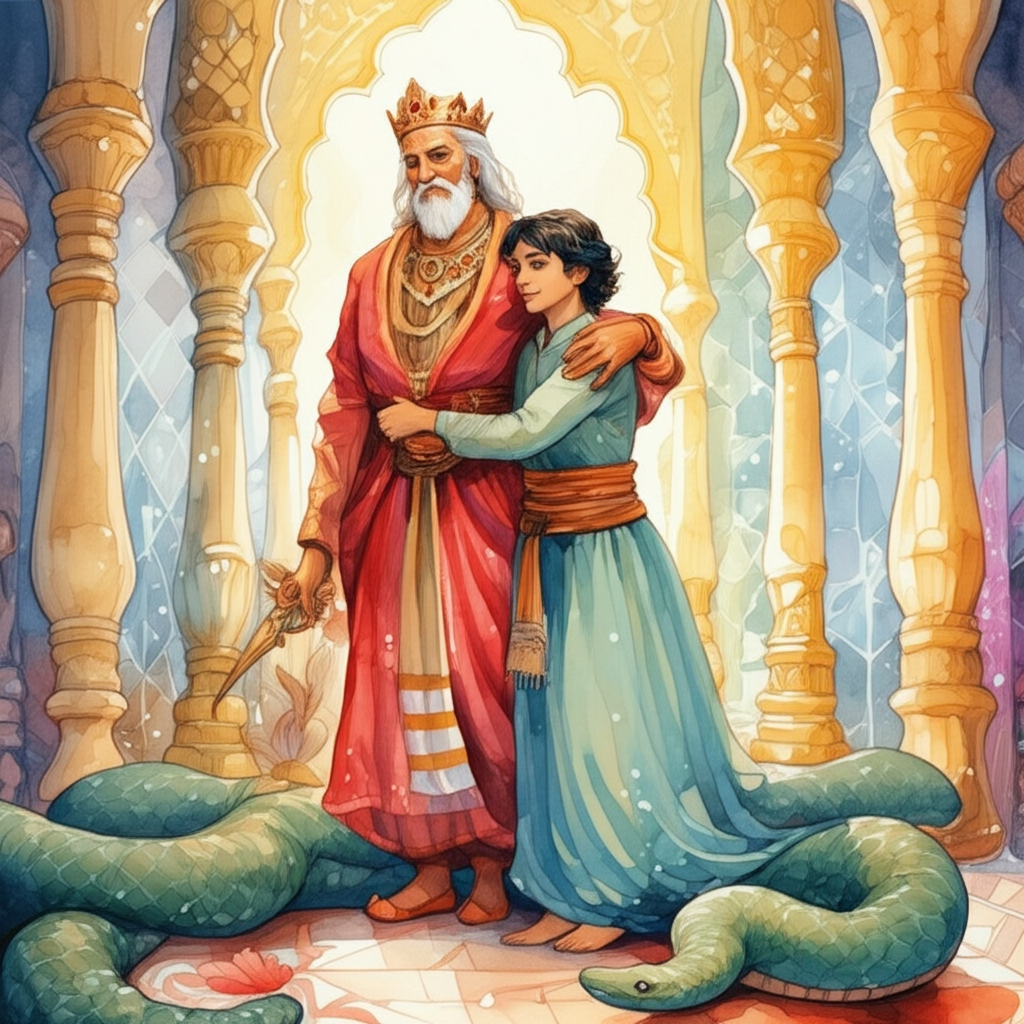
The son talked to the ring, and right away, a beautiful house and a lovely princess with golden hair appeared. He talked to the pot and spoon, too, and the most delicious food appeared for them. So, he married the princess, and they lived happily for many years. Then, one morning, the princess was getting ready and put her loose hairs into a little piece of straw and threw it into the river. The straw floated down the river for a long time. Finally, the prince of that country found it. He opened it and saw the golden hair. He loved the woman whose hair it was right away. He ran to his room, locked himself in, and wouldn’t come out. He wouldn’t eat, drink, sleep, or move until she was brought to him. The king, his father, was very worried. He didn’t know what to do. He thought his son might die and he wouldn’t have anyone to take over the kingdom. So, he decided to ask his aunt for help. She was a scary monster. The old woman said she would help him and told him not to worry, because she knew she could get the beautiful woman for his son to marry.
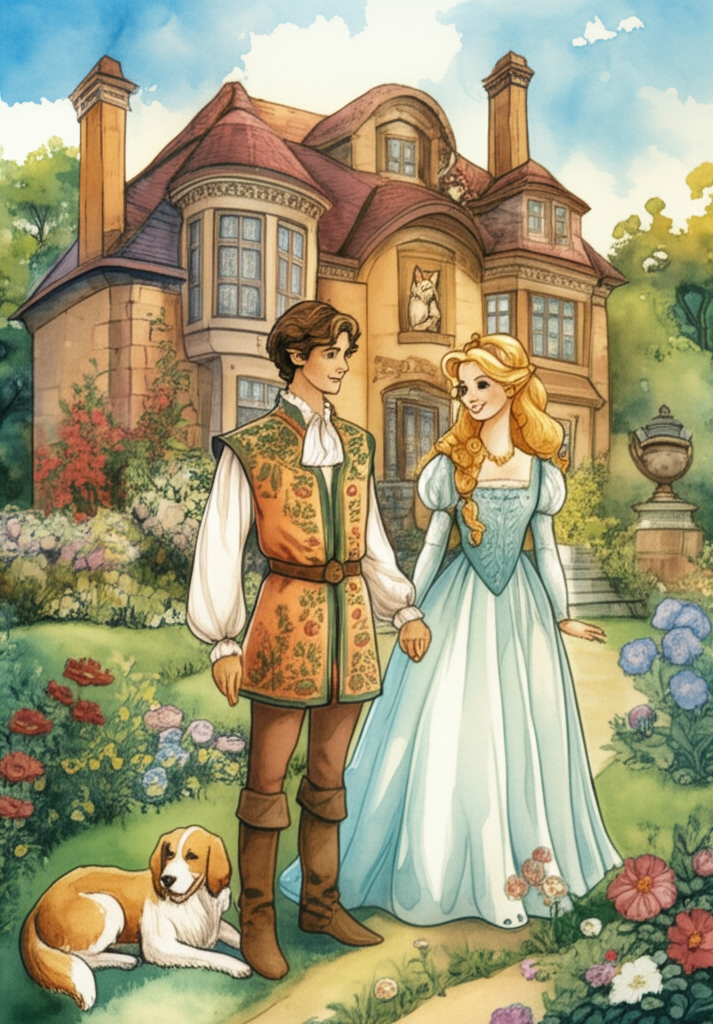
She turned into a bee and went buzzing around. She smelled the beautiful princess and found her. She looked like an old witch with a stick. She told the beautiful princess, “I’m your aunt! You’ve never seen me before because I left the country right after you were born.” She hugged and kissed the princess to make her believe her. The beautiful princess believed her. She hugged the monster back and asked her to stay as long as she wanted. She treated her so well that the monster thought, “I’ll get what I want soon!” After three days, she started talking about the magic ring. She told the princess that she should keep it instead of her husband, because he was always out hunting and might lose it. So, the beautiful princess asked her husband for the ring, and he gave it to her.
The monster waited another day before asking to see the ring. The beautiful princess showed it to her. Then, the monster grabbed the ring, turned back into a bee, and flew away to the palace, where the prince was almost dead. “Get up! Be happy! Don’t be sad anymore!” she said to him. “The woman you love will come when you call her. Here’s the magic charm to bring her to you.” The prince was so happy that he talked to the ring right away. The house and the beautiful princess appeared in the middle of the palace garden. He went into the house and told the beautiful princess how much he loved her. He asked her to marry him. She didn’t see any way out, so she said yes, but only if he would wait a month.
Meanwhile, the husband came back from hunting and was very upset that his house and wife were gone. There was just the empty place where he had used the ring. He sat down and decided to hurt himself. Then, the cat and dog came up. They had run away and hidden when they saw the house disappear. “Oh, master!” they said. “Don’t hurt yourself! It’s bad, but we can fix it. Give us a month, and we’ll go get your wife and house back!”
“Go,” he said. “And may God help you. Bring back my wife, and I’ll live.”
So, the cat and dog ran off and didn’t stop until they got to the place where their mistress and the house had been taken. “This might be hard,” said the cat. “Look, the king has taken our master’s wife and house for himself. You stay here. I’ll go to the house and try to see her.” So, the dog sat down, and the cat climbed up to the window of the room where the beautiful princess was sitting and went inside. The princess knew the cat and told it everything that had happened since she had left them.
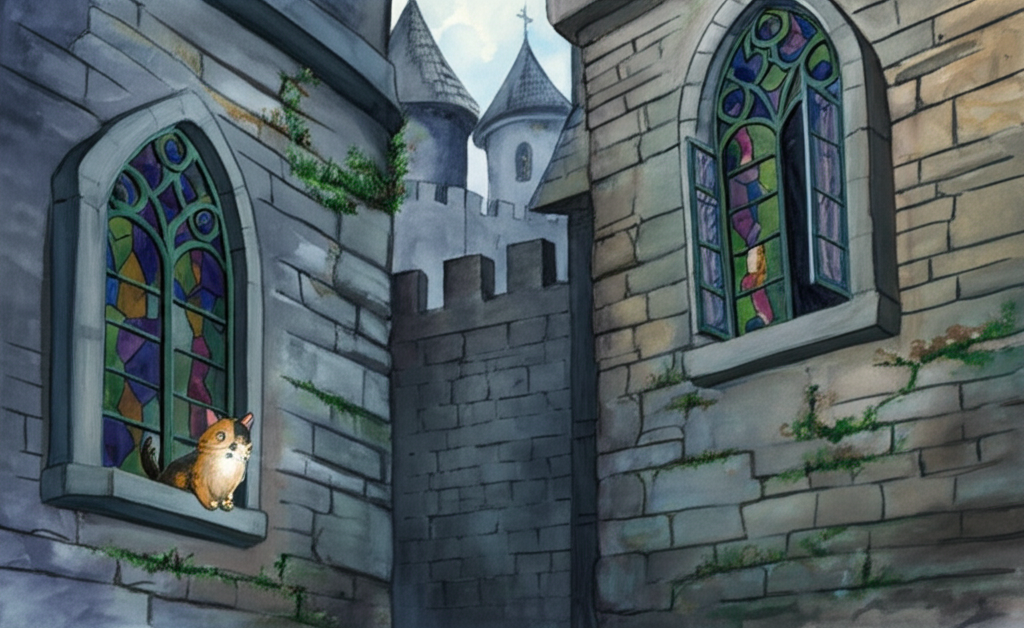
“But is there any way to escape from these people?” she asked.
“Yes,” said the cat, “if you can tell me where the magic ring is.”
“The ring is in the monster’s stomach,” she said.
“Okay,” said the cat, “I’ll get it back. If we get it, everything will be ours.” Then, the cat climbed down the wall of the house and went to a rat hole and pretended to be dead. At that time, there was a big wedding going on with the rats in that place. All the rats were together in that one hole where the cat was lying. The oldest son of the rat king was getting married. The cat knew this and decided to grab the groom and make him help. So, when the rats came out of the hole squeaking and jumping for the wedding, the cat saw the groom and jumped on him. “Oh, let me go!” cried the scared rat. “Oh, let him go!” squealed all the other rats. “It’s his wedding day!”
“No, no,” said the cat. “Not unless you do something for me. Listen. The monster who lives in that house with the prince and his wife has swallowed a ring, and I really want it. If you get it for me, I’ll let the rat go. If you don’t, then your prince dies right here.”
“Okay, we agree,” they all said. “If we don’t get the ring for you, you can eat us all!”
That was a big promise. But they did it. At midnight, when the monster was fast asleep, one of the rats went to her bed, climbed on her face, and put its tail into her throat. The monster coughed really hard, and the ring came out and rolled onto the floor. The rat grabbed the ring and ran back to its king, who was very happy. The king went to the cat and let his son go.
As soon as the cat got the ring, she ran back with the dog to tell their master the good news. Everything seemed safe now. They just had to give him the ring, and he would talk to it, and the house and beautiful princess would be back, and everything would be happy again. “Our master will be so happy!” they thought, and ran as fast as they could. On the way, they had to cross a river. The dog swam, and the cat sat on its back. The dog was jealous of the cat, so he asked for the ring and said he would throw the cat into the water if it didn’t give it up. So, the cat gave up the ring. That was bad, because the dog dropped it right away, and a fish swallowed it.
“Oh, what should I do? What should I do?” said the dog.
“What’s done is done,” said the cat. “We have to try to get it back. If we don’t, we should just drown ourselves in this river. I have a plan. You go kill a small lamb and bring it here to me.”
“Okay,” said the dog, and he ran off. He came back with a dead lamb and gave it to the cat. The cat got inside the lamb and lay down, telling the dog to go away and be quiet. Soon after, a nadhar, a bird that can break the bones of a fish just by looking at it, came and flew over the lamb. Then, it jumped down to carry it away. The cat came out and jumped on the bird. She said she would hurt it if it didn’t get the ring back. The nadhar said it would, and flew off to the king of the fishes. It told the king to find the ring and give it back. The king of the fishes did, and the ring was found and brought back to the cat.
“Come on, I got the ring!” said the cat to the dog.
“No, I won’t,” said the dog, “unless you let me have the ring. I can carry it too. Let me have it, or I’ll hurt you.” So, the cat had to give up the ring. The dog dropped it again. This time, a kite picked it up and flew away.
“See, see, there it goes—away to that big tree!” the cat shouted.
“Oh, oh! What have I done?” cried the dog.
“You silly thing, I knew that would happen,” said the cat. “But stop barking, or you’ll scare the bird away to some place where we can’t find it.”
The cat waited until it was dark, and then climbed the tree. She hurt the kite and got the ring back. “Come on,” she said to the dog when she got to the ground. “We have to hurry. We’ve been delayed. Our master will be sad. Come on.”
The dog was really sorry for all the trouble he had caused. He was afraid to ask for the ring again. They both got to their sad master and gave him the magic charm. Right away, his sadness turned into happiness. He talked to the ring, and his beautiful wife and house came back. He and everyone were happy again.
